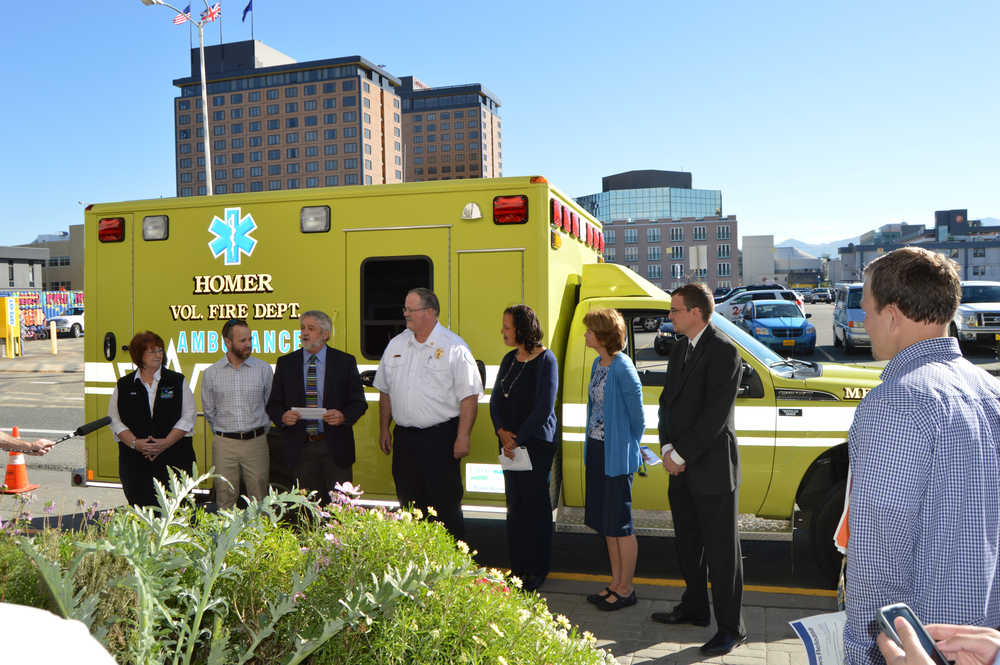Who genuinely wants to be in an ambulance? When one is necessary, however, having the most reliable form of medical transport is critical, especially for rural communities.
“This is a mobile emergency room,” said Homer Volunteer Fire Department Chief Bob Painter. “No one wants to break down or have a rough ride on the way.”
Painter, an EMS professional for 25 years, presented the new vehicle for the City of Homer at a U.S. Department of Agriculture Office of Rural Development announcement held Monday outside the Peterson Tower in Downtown Anchorage.
Not quite bumblebee and not quite sunflower, in terms of color, the “emergency yellow” ambulance was originally built at a plant in Florida, brought to Utah for lettering, and came via a TOTE Inc. ship into the Port of Anchorage where Painter was waiting to drive it back to Homer.
“We’re ecstatic,” Painter told the Alaska Journal of Commerce, standing in front of Homer’s new “Medic 3” and pointing out its attributes. The new ambulance, a Type 1 manufactured by Wheeled Coach, replaces a 20-year old model.
It offers improved reliability through its suspension, six-point harness and a crash-tested gurney system. In addition, the user-centric design, including LED lighting and updated electronics, is a modern convenience yet both economical and powerful, said Painter.
Because ambulances tend to cost $160,000 to $200,000, it is not easy for municipalities to replace aging vehicles. However, with the help of the USDA-RD grant, in the amount of $25,000, Homer’s new ambulance is now ready for service. The state of Alaska funded $70,000 while the city of Homer contributed the difference.
Bid proposals for the new ambulance went out in January with Rocky Mountain Ambulance the winning vendor.
The request for an ambulance in Homer was part of the Alaska Code Blue Project, a program established in the late 1990s to provide essential equipment for patient care, transportation and communications in rural communities. Southern Region EMS Council Inc. Executive Director Sue Hecks said that “essential” is the top criteria used to evaluate such requests.
When a project is on the approved Code Blue list, it is only after a thorough vetting process. The grant process, therefore, can take 16 months to 18 months while proposals are reviewed at the regional level, then by the state and, if sent to departments such as the USDA, are either awarded or denied. The USDA Office of Rural Development is comprised of three agencies dedicated to servicing rural areas through economic development and support. However, if grants from this organization were not available, Code Blue would seek out alternative avenues of funding.
“The need is great but funding is limited,” Hecks said, noting that financial challenges run from the federal down to the municipal level, with a decrease in available allocations in recent years. “
“It touches every community in Alaska,” she said.
However, because there is a lot of hands-on collaboration, with “everyone coming to the table,” the result is an unusual partnership of agencies with the ability to replace aging EMS equipment in rural communities throughout Alaska.
Equipment also does not necessarily mean ambulances. Alternative means of moving patients are considered depending on the community, such as traditional dog sleds, patient transport vehicles with pickup chassis, and snowmachines.
In attendance at the USDA-RD announcement were Sen. Lisa Murkowski, USDA-RD Under Secretary Lisa Mensah and USDA-RD Alaska State Director Jim Nordlund, among others. Andy Jones, Emergency Program Manager for the Alaska Department of Health and Social Services, thanked the USDA for its involvement.
“It’s things that you do so that others may live,” he said.
This year, a total of $810,221 in loans and grants have been awarded to organizations in Kodiak, Pelican, Barrow and Juneau. Recipients for 2016 are:
• Southern Region EMS Council Inc.: An Economic Impact Initiative Grant for $56,700 and a Community Facilities Grant for $14,500 will be used to purchase an ambulance to serve Kodiak and the U.S. Coast Guard Base.
• Maniilaq Association: An Economic Impact Initiative Grant for $50,000 will be used to purchase a transport vehicle for the village of Kivilina.
• City of Pelican: A Community Facility Loan of $425,500 and a Community Facilities Grant of $74,500 will be used to make improvements to the City-owned fuel dock.
• Ilisagvik Tribal College: A Tribal College Grant for $143,000 can be used for equipment purchase and improving educational facilities at the community college in Barrow.
• Tlingit Haida Regional Housing Authority: A Housing Preservation Grant of $46,021 will be used to repair senior housing in Juneau.
Stephanie Prokop is a reporter for the Alaska Journal of Commerce.


